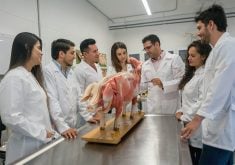The obituary for the local food movement may be in the preparatory stage.
And the roots of its demise may lie in its potential profits.
Tom Johnston, associate professor in the University of Lethbridge geography department, has studied farmers’ markets and the local food movement, which he said is probably one of the fastest growing segments in food sales. Ten years ago, organic food shared the top spot.
“If there’s money to be made, the local food movement will be appropriated by large blocks of capital by the retail chains and the agri-food businesses,” said Johnston in a May 26 presentation to the Southern Alberta Council of Public Affairs.
Read Also

Fuel rebate rule change will affect taxes and AgriStability
The federal government recently announced updates to the fuel rebates that farmers have been receiving since 2019-20.
And there is money to be made. Johnston said his data shows the average household income of a farmers’ market shopper is three times that of the average household in Lethbridge.
“If there’s money to be made, and it makes good business sense, then the big boys will come to the dance,” he said.
One food store chain has already implemented a “close to home” campaign and others will likely follow.
Canada is following trends similar to the United States in farmers’ markets and local food procurement, said Johnston. In the 10 years up to 2007, direct to consumer sales were $1.2 billion, up from $500 million a decade earlier. The number of farmers’ markets increased by more than 3,000 percent in that same period in the U.S., he said.
Johnston said consumers are concerned about the carbon footprint of transporting produce, the use of agricultural chemicals, animal welfare, food quality and support for family farms.
But local food isn’t necessarily lowering carbon consumption if one considers the entire process, he said.
“Well, the dirty little secret is the cost of the fuel that is taken up by transporting products pales in comparison with the energy used to produce commodities. It is less than … five percent of the total.”
Similarly, local food may not be as local as people think if a full cost accounting is taken.…,” he said.
However, there is an argument to be made for superior quality of food procured at the local level.
Johnston likes to tell the story of the 13 m.p.h. tomato as an example of how human intervention combined with economics have reduced the quality of food.
Decades ago, California farmers asked engineers at the University of California Davis to build a tomato harvester so they would be less reliant on human labour.
And a harvester was built.
“The problem was, the tomatoes they were growing at the time didn’t work very well with the tomato harvester because the terminal velocity of a tomato dropping into an empty bin from a conveyor belt is 13 m.p. h,” he said.
Farmers again sought a solution. Harvester engineers approached agronomists and asked them to breed a tomato that could withstand a velocity of 13 m.p.h.
“The problem is, it doesn’t taste much like a tomato, in my view,” he said.
Johnston said these tomatoes are the reason people seek tasty local food.
———
none















